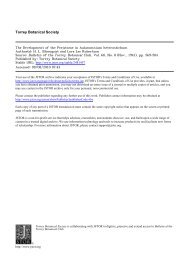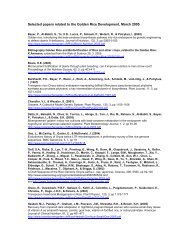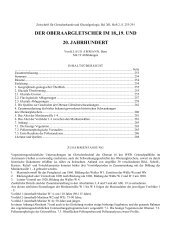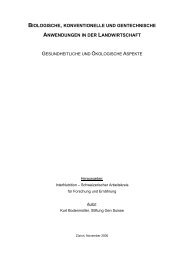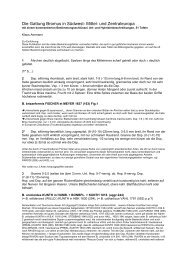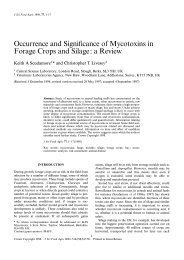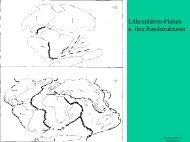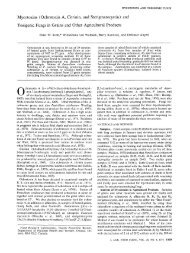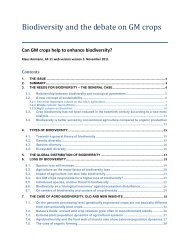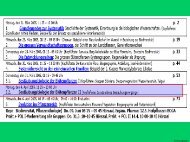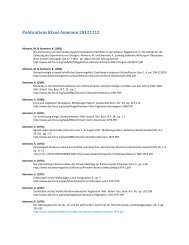Genetic engineering of plants to enhance resistance to fungal ...
Genetic engineering of plants to enhance resistance to fungal ...
Genetic engineering of plants to enhance resistance to fungal ...
You also want an ePaper? Increase the reach of your titles
YUMPU automatically turns print PDFs into web optimized ePapers that Google loves.
Punja: genetic <strong>engineering</strong> / <strong>fungal</strong> disease <strong>resistance</strong> 221<br />
Table 1 (continued).<br />
Strategy used and plant species<br />
engineered Expressed gene product Effect on disease development Reference<br />
Wheat (T. aestivum)<br />
Aspergillus giganteus<br />
anti<strong>fungal</strong> protein<br />
Rice TLP<br />
Reduced development <strong>of</strong> colonies <strong>of</strong><br />
Blumeria graminis and Puccinia<br />
recondita<br />
Delayed development <strong>of</strong> Fusarium<br />
graminearum<br />
Expression <strong>of</strong> antimicrobial proteins, peptides, or compounds<br />
Arabidopsis thaliana L. Arabidopsis thionin Reduced development and colonization<br />
by Fusarium oxysporum<br />
Mistle<strong>to</strong>e thionin Reduced infection and development <strong>of</strong><br />
visco<strong>to</strong>xin<br />
Plasmodiophora brassicae<br />
Carrot (D. carota) Human lysozyme Enhanced <strong>resistance</strong> <strong>to</strong> Erysiphe heraclei<br />
and Alternaria dauci<br />
Geranium (Pelargonium sp.) Onion antimicrobial Reduced development and sporulation <strong>of</strong><br />
protein<br />
Botrytis cinerea<br />
Pota<strong>to</strong> (S. tuberosum) Alfalfa defensin Enhanced <strong>resistance</strong> <strong>to</strong> Verticillium<br />
dahliae<br />
Bacillus<br />
amyloliquefaciens<br />
barnase (RNase)<br />
Synthetic cationic<br />
peptide chimera<br />
Delayed sporulation and reduced<br />
sporangia production by Phy<strong>to</strong>phthora<br />
infestans<br />
Reduced development <strong>of</strong> Fusarium<br />
solani and Phy<strong>to</strong>phthora cac<strong>to</strong>rum<br />
Oldach et al. (2001)<br />
Chen et al. (1999)<br />
Epple et al. (1997)<br />
Hol<strong>to</strong>rf et al. (1998)<br />
Takaichi and Oeda (2000)<br />
Bi et al. (1999)<br />
Gao et al. (2000)<br />
Strittmatter et al. (1995)<br />
Osusky et al. (2000)<br />
Human lact<strong>of</strong>errin Not tested Chong and Langridge<br />
(2000)<br />
Rice (O. sativa) Maize RIP No effect on Magnaporthe grisea or Kim et al. (1999)<br />
Rhizoc<strong>to</strong>nia solani<br />
Tobacco (N. tabacum)<br />
Amaranthus hevein-type No effect on Alternaria longipes or De Bolle et al. (1996)<br />
peptide, Mirabilis<br />
knottin-type peptide<br />
Botrytis cinerea<br />
Radish defensin Reduced infection and lesion size due <strong>to</strong> Terras et al. (1995)<br />
Alternaria longipes<br />
Barley RIP<br />
Reduced incidence and severity <strong>of</strong> Logemann et al. (1992)<br />
Rhizoc<strong>to</strong>nia solani<br />
Maize RIP Lower damage due <strong>to</strong> Rhizoc<strong>to</strong>nia solani Maddaloni et al. (1997)<br />
Pokeweed antiviral<br />
protein<br />
Lower rate <strong>of</strong> infection and mortality<br />
due <strong>to</strong> Rhizoc<strong>to</strong>nia solani<br />
Wang et al. (1998);<br />
Zoubenko et al. (1997)<br />
Sarco<strong>to</strong>xin peptide<br />
from Sarcophaga<br />
peregrina<br />
Stinging nettle (Urtica<br />
dioica L.) isolectin<br />
Anti<strong>fungal</strong> (killing)<br />
protein from virus<br />
infecting Ustilago<br />
maydis (dsRNA)<br />
Chloroperoxidase from<br />
Pseudomonas<br />
pyrrocinia<br />
Synthetic antimicrobial<br />
peptide<br />
Synthetic magainintype<br />
peptide<br />
Human lysozyme<br />
Enhanced seedling survival following Mitsuhara et al. (2000)<br />
inoculation with Rhizoc<strong>to</strong>nia solani,<br />
Pythium aphanidermatum, andPhy<strong>to</strong>phthora<br />
nicotianae<br />
Not tested Does et al. (1999)<br />
Not tested Park et al. (1996)<br />
Reduced lesion development by<br />
Colle<strong>to</strong>trichum destructivum<br />
Reduced lesion size due <strong>to</strong><br />
Colle<strong>to</strong>trichum destructivum<br />
Reduced lesion size and sporulation due<br />
<strong>to</strong> Peronospora tabacina<br />
Reduced colony size and conidial production<br />
by Erysiphe cichoracearum<br />
Toma<strong>to</strong> (L. esculentum) Radish defensin Reduced number and size <strong>of</strong> lesions due<br />
<strong>to</strong> Alternaria solani<br />
Rajasekaran et al. (2000)<br />
Cary et al. (2000)<br />
Li et al. (2001)<br />
Nakajima et al. (1997)<br />
Parashina et al. (2000)



